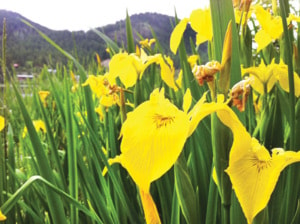Volunteers are needed to help stop the spread of a harmful invasive species in the White Lake area.
A collaboration of the White Lake stewards and community residents, the Shuswap Trail Alliance, BC Parks, Columbia Shuswap Invasive Species Society and Thompson Rivers University are looking for help with eradicating Yellow Flag Iris populations on June 2 and 3.
The Yellow Flag Iris is a bright yellow perennial that threatens plant and animal diversity by growing in dense stands in wet areas.
The Invasive Species Council of B.C.’s website says several hundred irises can be connected by their root system underwater and that fragments can form new plants when they drift downstream.
This resilient root network, coupled with the iris’ widespread sale as a decorative plant, make it very difficult to eradicate.
The White Lake effort will begin on Thursday, June 2 at 4 p.m.
“We need crews to visit all the yellow flag infestation sites on Little White Lake, chop the plants down to their base, and collect the vegetation for removal from the lake,” said the bulletin from the Shuswap Trail Alliance.
Volunteers are also required the following evening, Friday June 3 to treat the infested area by placing a benthic barrier overtop of the chopped plants and securing it with rocks. This will be a short session followed by a celebratory potluck.
Carmen Massey of the White Lake Stewards, said there has been a small patch of Yellow Flag Iris at one end of little White Lake for approximately 40 years, but it has begun to spread rapidly over the last five years.
Massey said the infestation is mainly contained to Little White Lake, but is beginning to appear in Big White Lake. BC Parks is helping with the project in order to protect the provincial park and protected shoreline habitat that they operate on the north shore of White Lake.
A study conducted by TRU Professor Catherine Tarasoff suggests that along with forcing out local plant species, the iris turns rocky shorelines to muddy soil shorelines. Tarasoff said the changes to the shoreline can adversely affect aquatic invertebrate populations, which are an essential food source for birds and fish.
Tarasoff’s study also found that using the benthic barrier to cover the iris’s root system can effectively kill it. Tests were conducted on eight other iris populations across B.C. effectively killing each of them. Tarasoff said a local Grade 8 class will be treating and monitoring a site of their own on the lake as a class project.
Massey said that for the past few years volunteers have tried to control the spread of the iris by chopping off the tops of the plants, stopping them from spreading seeds and therefore limiting the infestation’s spread. Massey was optimistic that a more thorough chopping and the application of the barrier would solve the problem entirely.
If the eradication is successful, the barriers could be removed in the fall and replanting of native vegetation could begin by next spring, Massey said.
Volunteers are asked to meet at Massey Yard, 3163 White Lake Road, and bring boats and hip waders if they have them.
For more information contact Carmen Massey at 250-804-3466 or ctmassey@hotmail.com.
